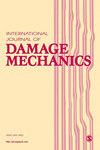基于能量的韧性材料低循环疲劳损伤模型
IF 3.9
2区 工程技术
Q2 MATERIALS SCIENCE, MULTIDISCIPLINARY
引用次数: 0
摘要
本文介绍了一种基于单元元素连接的疲劳损伤累积单轴材料模型。虽然这些单元在所提出的模型中被视为微元,但它们是基于滞后算子的,能够以分析表达式计算滞后能量损失。此外,该单元元素还代表了一种机械模型,具有与应变函数相关的弹塑性损伤行为。第二层建模是由这些单元(微元素)与不同的破坏时总能量耗散值的连接定义的。通过改变耗散能量极限的分布,可开发出各种疲劳损伤演变规律。一个加载周期内总能量和滞后能量损失的计算也会受到疲劳损伤的影响,因为不同数量的单元元件在达到最大耗散能量时会被消除。模型的材料参数是根据单调应力应变试验和循环应力应变试验确定的,但由于本文的主要优势和目的是开发疲劳分析中损伤演变的评估方法,因此没有进行详细比较。另一方面,本文从定性和定量两个方面对失效循环次数(Nf)和总散热量与实验结果进行了比较。最后,基于所提出的模型,构建了平均应变和载荷序列效应图。结果表明,所提出的模型可以可靠地估算低循环加载条件下的疲劳寿命。在应变振幅小于 5%的恒定应变加载实验中,计算 Nf 的最大误差为 3%。在加载序列疲劳寿命估算中,所提出的模型表现出良好的准确性,最大误差为 34%。此外,对于相同的材料和疲劳寿命,可定义不同类型的损伤演变,从而获得不同的结果。本文章由计算机程序翻译,如有差异,请以英文原文为准。
Energy based damage model for low-cycle fatigue of ductile materials
A uniaxial material model for fatigue damage accumulation, established on the connection of unit elements, is presented in this paper. Although these units are regarded as micro-elements in the proposed model, they are based on a hysteretic operator that enables calculating hysteretic energy loss as an analytical expression. Further, this unit element represents a mechanical model with elastoplastic damage behavior in function of strain. The second level of modeling is defined by the connection of these units (micro-elements) with different values of total energy dissipated at failure. By changing the distribution of dissipated energy limit, various fatigue damage evolution laws are developed. Calculation of total and hysteretic energy loss in one loading cycle is also affected by fatigue damage as the varying number of unit elements are been eliminated when their maximum dissipation energy is reached. Material parameters for the model were defined based on the experimental monotonic and cyclic stress-strain tests, still, detailed comparison was not performed as the main advantage and aim of the paper was the development of the method for assessment of damage evolution in fatigue analysis. On the other hand, the number of cycles to failure ( Nf ) and total heat dissipation are compared in both qualitative and quantitative aspects with experimental results. Finally, based on the proposed model, mean strain and load sequence effect diagrams were constructed. It is shown that the proposed model can provide a reliable estimation of fatigue life in the low-cycle regime of loading. The maximum error for the calculated Nf was 3% for constant strain loading for experiments with strain amplitude less than 5%. In load sequence fatigue life estimation, the proposed model demonstrated good accuracy, with a maximum error of 34%. Further, obtained results were achieved with different types of damage evolution that could be defined for the same material and fatigue life.
求助全文
通过发布文献求助,成功后即可免费获取论文全文。
去求助
来源期刊

International Journal of Damage Mechanics
工程技术-材料科学:综合
CiteScore
8.70
自引率
26.20%
发文量
48
审稿时长
5.4 months
期刊介绍:
Featuring original, peer-reviewed papers by leading specialists from around the world, the International Journal of Damage Mechanics covers new developments in the science and engineering of fracture and damage mechanics.
Devoted to the prompt publication of original papers reporting the results of experimental or theoretical work on any aspect of research in the mechanics of fracture and damage assessment, the journal provides an effective mechanism to disseminate information not only within the research community but also between the reseach laboratory and industrial design department.
The journal also promotes and contributes to development of the concept of damage mechanics. This journal is a member of the Committee on Publication Ethics (COPE).
 求助内容:
求助内容: 应助结果提醒方式:
应助结果提醒方式:


